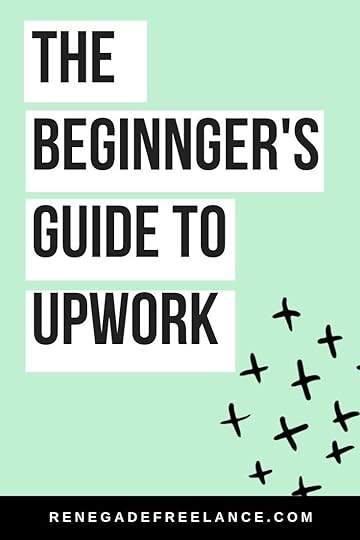The Beginner's Guide To Upwork

The Beginners Guide
To Getting Started on Upwork
Based on my experience, the easiest and fastest way to start your own business and earn a full-time income from home is to start freelancing, and the fastest easiest way to start freelancing is Upwork.
I tried blogging, affiliate marketing, drop-shipping, print-on-demand, day trading, stock photography and even dog walking, but nothing ever worked as well as freelancing did. I could never seem to get enough leads or enough traffic or the profit margins were too low. All that changed when I tried Upwork.
Upwork is the largest freelancing platform out there. It works like a job board connecting freelancers and businesses who need their services, but it’s so much more than that. It’s also your messaging platform and your payment processor. It’s everything you need to run your freelancing business in one place.
Upwork is your key to working on your schedule, from home or abroad while making a full-time income and you don’t even need a website to do it. Imagine being your boss, setting your rates and working whenever you want.
Companies benefit from hiring from Upwork because they don’t have to pay benefits or babysit employees. Don’t believe the myth that there aren’t high-paying jobs on Upwork either. Upwork is an ecosystem with a full range of jobs and budgets for beginners to experts.
Are you convinced you need to be on Upwork yet? Here’s how to get started.
Sign up to become a freelancer on Upwork.com.You will need to enter your name and email address. Upwork should then send you a verification email which will take you to the next step in the process.
Upwork now has an approval process and freelancers will often not get approved the first time around, but I have some tips for getting through. Be as thorough as you can and fill in education and work history including skills that apply to your freelance work and any non-formal education that can boost your qualifications.
Make sure to include examples of past work in your portfolio (with screen-shots, graphics, or photos). If you don’t have any projects to use in your portfolio, I advise you to create some of your own (for example, design a website, create a youtube channel, etc. for yourself if you don’t have any others you can use). Use yourself as a case study if you need to.
Your photo should be clear (not pixelated), showing your whole face (no sunglasses) and you will want to make sure you’re smiling. Don’t get stuck on this step though. Your photo will be very small so don’t feel like you need a professional headshot.
If you pick a specialty to highlight in your profile title and description, you will be competing against fewer freelancers. If you focus on social media marketing, for example, you will have too much competition. But if you focus on Facebook, you can be seen as one of the top experts on that subject.
If you’re just starting, I recommend creating a client account and analyzing other freelancer’s profiles. Use the filters to search for experts in your specialty and country. I recommend pricing yourself in the same range as what others are charging. Once you have as many clients as you want, you can start raising your rates from there.
Upwork does charge a percentage of the money you make on the platform. I’m happy to pay these fees because Upwork is sending me high-quality leads, so I think of them as a commission-only salesperson.
Specifically, Upwork charges a fee of:
20% for the first $500 billed with the client
10% for lifetime billings with the client between $500.01 and $10,000
5% for lifetime billings with the client that exceed $10,000
For this reason, it’s better to work with clients long-term because your Upwork fees for each client will decrease over time. Make sure you consider fees when setting your pricing.
Get paid.Once you have an account set up, you will want to connect your bank account so that you can receive payments. I have payments automatically sent to my bank account every week. You can receive funds via whatever payment methods work best for you:
Direct Deposit / ACH
PayPal
Wire Transfer
Local Funds Transfer (LFT)
Payoneer
Skrill
Get comfortable with the platform.I have seen many potential freelancers give up because they’re not used to spending time online or navigating the platform. I recommend creating a client and freelancer account so you can compare what the client sees and the different filters they might use to search for you. You will also want to get used to the filters for finding work. If you set aside just an hour to click around and get comfortable with the different areas of the site you will be doing yourself a huge favor.
Commit to a schedule.Being successful in Upwork doesn’t have to take up a lot of time. I spend about half an hour each day searching for and applying to new jobs. Since I have a template customized to my niche, I only have to make a few edits for each job and then I’m already done prospecting for the day. When you’re new to Upwork, I recommend searching for new jobs each day to increase your chances of getting hired.
Craft a perfect pitch.I like to use templates that I can edit for each job. Once you start applying, you will learn exactly what clients are looking for and you can adjust your pitch accordingly. For example, I’ve found that including examples of past projects and testimonials skips a lot of back and forth and increases my chances of getting hired.
Pro-tip. Use a call to action in your pitch. By asking your client for more information like a link to their website, you entice them to start a conversation with you and helps to build trust. Your pitch should be well formatted and easy to skim with small paragraphs and bullet points instead of large blocks of text. Read the job description carefully and make sure you address each client’s needs.
Get your first review.This is the key to getting hired on Upwork. Clients use reviews to help them choose the best person for the job, so if you don’t have any review history you are unlikely to get hired. This is an obstacle for first-time freelancers.
My advice is to find a friend, neighbor, acquaintance, family member, past employer, etc. who can genuinely use your services and see if they’re willing to hire you on Upwork.
Alternatively, you can explain the situation to clients in your proposals by stating that you’re new to Upwork, but not to your industry and you’re willing to offer them a discount while you build your portfolio. You can also include work references or recommendation letters for jobs you’ve had in the past.
Set clear expectations.There are good and bad clients out there and you want to avoid the bad ones. To be successful on Upwork you want to keep a high job success score because clients look at this metric when deciding whether to hire you.
The money from a bad client is not worth risking a bad review, which is why I set firm expectations, deliverables, deadlines, and availability in a client agreement before I ever agree to work with someone. This helps weed out the bad clients who will treat you like an employee and expect you to be at their beck- and-call, 24/7.
Screen clients.Another way to avoid bad clients is to check their past feedback. Clients have profiles just like freelancers, and anyone who has worked with them in the past can leave a review. You can check their rating and reviews from past freelancers to identify and avoid difficult clients.
Don’t think about your applications.After you apply to a job, I want you to forget about it. Many freelancers give up on Upwork too soon because they applied for a few jobs and never heard back, and they think that means it isn’t working for them.
Don’t ever get discouraged because I promise that not hearing back is normal. You need to be applying to every qualified job, every day. To get my 12 clients, I applied to hundreds and hundreds of jobs. Upwork now charges a small fee (called connects) for every job you apply to, but my advice is to buy as many connections as it takes. Just keep applying and tweaking your pitch until you find what works.
Stay organized.Once you start getting clients, you will need a way to keep track of all the tasks for each one. I recommend using a free project management program like Asana or Trello to keep client information organized, manage your to-do-list and keep track of deadlines. Google docs is another great tool.
Do a good job.Meet deadlines. Answer questions in a timely manner. Under promise and overdeliver.



